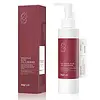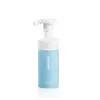What's inside
What's inside
 Key Ingredients
Key Ingredients

 Benefits
Benefits

 Concerns
Concerns

 Ingredients Side-by-side
Ingredients Side-by-side

Water
Skin ConditioningGlycerin
HumectantCoco-Betaine
CleansingDipropylene Glycol
HumectantPotassium Cocoyl Glycinate
Acrylates Copolymer
Potassium Cocoate
EmulsifyingSalicylic Acid
MaskingCaprylyl Glycol
EmollientHydroxyacetophenone
AntioxidantPolyglyceryl-10 Myristate
Skin ConditioningEthylhexylglycerin
Skin ConditioningHibiscus Syriacus Flower Extract
AntioxidantDipotassium Glycyrrhizate
HumectantGlycolic Acid
BufferingXylitylglucoside
HumectantAnhydroxylitol
HumectantXylitol
HumectantGlucose
HumectantWater, Glycerin, Coco-Betaine, Dipropylene Glycol, Potassium Cocoyl Glycinate, Acrylates Copolymer, Potassium Cocoate, Salicylic Acid, Caprylyl Glycol, Hydroxyacetophenone, Polyglyceryl-10 Myristate, Ethylhexylglycerin, Hibiscus Syriacus Flower Extract, Dipotassium Glycyrrhizate, Glycolic Acid, Xylitylglucoside, Anhydroxylitol, Xylitol, Glucose
Water
Skin ConditioningGlycerin
HumectantPolyglycerin-10
HumectantSodium Lauroamphoacetate
CleansingDisodium Laureth Sulfosuccinate
CleansingCocamidopropyl Betaine
CleansingPEG-8
HumectantSodium Chloride
MaskingDisodium Lauroamphodiacetate
CleansingPolyquaternium-7
Trehalose
HumectantLauryl Betaine
CleansingSodium Methyl Cocoyl Taurate
Cleansing1,2-Hexanediol
Skin ConditioningChlorphenesin
AntimicrobialEthylhexylglycerin
Skin ConditioningDisodium EDTA
Methylpropanediol
SolventSodium Hyaluronate
HumectantNiacinamide
SmoothingPanthenol
Skin ConditioningStephania Tetrandra Root Extract
Skin ConditioningHydrolyzed Hyaluronic Acid
HumectantHydroxypropyltrimonium Hyaluronate
Sodium Acetylated Hyaluronate
HumectantHyaluronic Acid
HumectantHydrolyzed Sodium Hyaluronate
Skin ConditioningPotassium Hyaluronate
Skin ConditioningSodium Hyaluronate Crosspolymer
HumectantSodium Hyaluronate Dimethylsilanol
HumectantCeramide EOP
Skin ConditioningCeramide AP
Skin ConditioningCeramide NP
Skin ConditioningCarica Papaya Fruit Extract
Skin ConditioningAnanas Sativus Fruit Extract
Skin ConditioningDiospyros Kaki Peel Extract
Skin ConditioningPhenoxyethanol
PreservativeWater, Glycerin, Polyglycerin-10, Sodium Lauroamphoacetate, Disodium Laureth Sulfosuccinate, Cocamidopropyl Betaine, PEG-8, Sodium Chloride, Disodium Lauroamphodiacetate, Polyquaternium-7, Trehalose, Lauryl Betaine, Sodium Methyl Cocoyl Taurate, 1,2-Hexanediol, Chlorphenesin, Ethylhexylglycerin, Disodium EDTA, Methylpropanediol, Sodium Hyaluronate, Niacinamide, Panthenol, Stephania Tetrandra Root Extract, Hydrolyzed Hyaluronic Acid, Hydroxypropyltrimonium Hyaluronate, Sodium Acetylated Hyaluronate, Hyaluronic Acid, Hydrolyzed Sodium Hyaluronate, Potassium Hyaluronate, Sodium Hyaluronate Crosspolymer, Sodium Hyaluronate Dimethylsilanol, Ceramide EOP, Ceramide AP, Ceramide NP, Carica Papaya Fruit Extract, Ananas Sativus Fruit Extract, Diospyros Kaki Peel Extract, Phenoxyethanol
Ingredients Explained
These ingredients are found in both products.
Ingredients higher up in an ingredient list are typically present in a larger amount.
Ethylhexylglycerin (we can't pronounce this either) is commonly used as a preservative and skin softener. It is derived from glyceryl.
You might see Ethylhexylglycerin often paired with other preservatives such as phenoxyethanol. Ethylhexylglycerin has been found to increase the effectiveness of these other preservatives.
Glycerin is already naturally found in your skin. It helps moisturize and protect your skin.
A study from 2016 found glycerin to be more effective as a humectant than AHAs and hyaluronic acid.
As a humectant, it helps the skin stay hydrated by pulling moisture to your skin. The low molecular weight of glycerin allows it to pull moisture into the deeper layers of your skin.
Hydrated skin improves your skin barrier; Your skin barrier helps protect against irritants and bacteria.
Glycerin has also been found to have antimicrobial and antiviral properties. Due to these properties, glycerin is often used in wound and burn treatments.
In cosmetics, glycerin is usually derived from plants such as soybean or palm. However, it can also be sourced from animals, such as tallow or animal fat.
This ingredient is organic, colorless, odorless, and non-toxic.
Glycerin is the name for this ingredient in American English. British English uses Glycerol/Glycerine.
Learn more about GlycerinWater. It's the most common cosmetic ingredient of all. You'll usually see it at the top of ingredient lists, meaning that it makes up the largest part of the product.
So why is it so popular? Water most often acts as a solvent - this means that it helps dissolve other ingredients into the formulation.
You'll also recognize water as that liquid we all need to stay alive. If you see this, drink a glass of water. Stay hydrated!
Learn more about Water